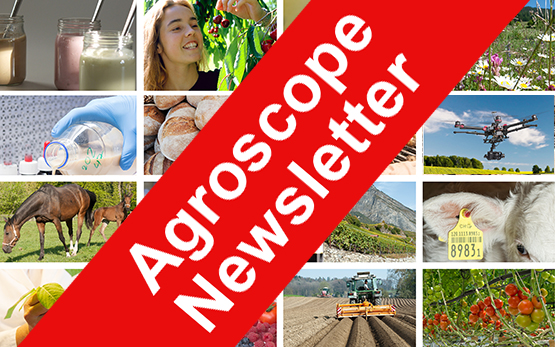Secrets of honey-making by bees unveiled
Bern, 09.09.2016 - From never seen before X-ray images of honey bee combs, a research team from Agroscope and the Institute of Bee Health at the University of Bern (both Switzerland) could study how honey is produced. The team used computer tomography to measure sugar concentration in the wax cells, without disturb-ing the sensitive mechanisms of the colony. They found that bees use several techniques to ripen honey.
Honeybees collect nectar from flowers and concentrate the sugar it contains to produce honey. Honey reserves in their wax combs allow colonies to survive over winter when no food is available in the environment. This rich source of sugar is also appreciated by humans and honey is harvested for consumption. Despite the importance of honey for honey bee and humans societies, little is known about its production by worker bees.
In an article in the open-access journal PLOS ONE, a joint research team from Agroscope at the Swiss Confederation and from the Institute of Bee Health at the University of Bern (Switzerland) could quantify the changes in sugar concentration in wax cells during honey production by worker bees.
‘Due to the technical difficulties of measuring sugar concentration in wax cells without disturbing the bees, we still ignore much of how nectar is transformed into honey’, says senior author Vincent Dietemann from Agroscope. ‘Computer tomography is conventionally used to examine humans or animals for medical purpose, but here we used this technique to scan whole honey bee hives. We could, for the first time, measure and literally see the sugar concentration of honey in the wax cells’ adds lead author Michael Eyer from both Agroscope and Institute of Bee Health, who has been working on this project for the past two years.
Secrets discovered in the cells
During the honey ripening process in the cells, X-ray images showed different patterns of brightness that reflect sugar concentration. The patterns indicate that workers use different behaviours to produce honey. They either paint the walls with loads of concentrated nectar to create rings (fig 2) or deposit them randomly in the cell, forming clumps (fig 3). Over time, clumps grow in size and ring patterns disappear to converge to the inhomogeneous pattern of ripe honey (fig 4).
Surprisingly, ripe honey thus turns out to be a matrix of inhomogeneous sugar concentration (fig 4). A few cells showed a content of homogeneous high sugar concentration (fig 5) and this concentration exceeded the average normally measured for honey. ‘These new findings were unexpected based on previous knowledge and complete our understanding of honey making by bees’ explains Peter Neumann from the Institute of Bee Health, who also took part to the study.
Understanding honey production and storage is important for beekeeping and for colony health
The new findings resulted in the most detailed insight into honey ripening available to date. Increased knowledge on the honey production by bees is of high importance to beekeepers, since it might lead to better management of colonies to improve the quality and quantity of honey harvests. In addition, by tracking the destiny of nectar brought back to the hive by the forager bees, such studies could contribute to a better understanding of hive contamination by pathogens and pesticides, two currently important fields of research in honeybee health.
Honey production, use and computer tomography - Background
Honey bees collect their food from plants in their environment. Floral pollen is the honey bee’s main source of protein. Nectar gained from flowers and honeydew derived from plant-sucking insects, provide the sugars to fuel their muscle activity. During honey production, enzymes are added to nectar and honeydew by the bees and water is eliminated to concentrate sugar. Water is evaporated actively by workers who manipulate regurgitated droplets of nectar with their mouthparts. In parallel, passive evaporation operates on the cell content.
Honey is a rich source of sugar exploited by humans since at least 15,000 years. In addition to its role as sweetener, honey is also used for its health benefits that include healing of wounds and fighting off infections. Switzerland has an annual average honey production of 3‘400 tons, with an annual consumption of 1.3 kg honey per person.
Computer tomography generates three dimensional X-ray images and is based on the measurement of density and the visualization and quantification of the differences in density of the component materials. Since the density of a sugar solution varies with its concentration, the former parameter can be used as a proxy for the latter.
Article citation
Eyer M, Neumann P, Dietemann V (2016) A Look into the Cell: Honey Storage in Honey Bees, Apis mellifera. PLOS ONE 11(8): e0161059. http://dx.doi.org/10.1371/journal.pone.0161059.
The study was supported by the Vinetum Foundation, the Foundation Sur-La-Croix and Agroscope. It was performed by researchers from Agroscope, Switzerland (Swiss Bee Research Center, Swiss Confederation) and the University of Bern, Switzerland (Institute of Bee Health, Vetsuisse Faculty).
Address for enquiries
Dr. Michael Eyer
Agroscope, Swiss Bee Research Center / Institute of Bee Health, Vetsuisse Faculty, University of Bern
Schwarzenburgstr. 161, 3003 Bern, Switzerland
michael.eyer@students.unibe.ch
+41 76 374 73 65
Ariane Sotoudeh, Media Service
Corporate Communication Agroscope
Rte de la Tioleyre 4, 1725 Posieux, Switzerland
ariane.sotoudeh@agroscope.admin.ch
+41 58 482 61 05
www.agroscope.ch| good food, healthy environment
Publisher
AGROSCOPE
http://www.agroscope.admin.ch






